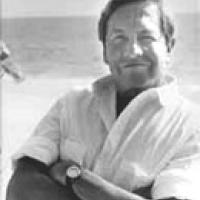“The possibility always exists to nourish an important new genius in learning-disabled children, if their spirit is not broken and creative dreams are allowed to develop.”
Robert Rauschenberg’s works now hang in major art galleries and museums such as the National Gallery of Art in Washington, D.C. Though his work is recognized worldwide, when he was in school his success would not have been predicted. Rauschenberg has dyslexia, a reading disability that made school very difficult for him. “I was considered slow. While my classmates were reading their textbooks, I drew in the margins,” Rauschenberg tells an interviewer.
Though Rauschenberg had difficulty reading he likes to put words into his artwork. He often misspells them. He also likes to play word games, for example, creating palindromes (words that can be read forward and backward.). One of his famous works of art is titled “Able was I ere I saw Elba.” It is based on a famous painting of the emperor Napoleon. Napoleon was exiled to the French island of Elba.
Dyslexia even helps him in his art. He likes to create prints that combine several different pictures. In an interview he stated that “I got hooked. Also because I am dyslexic, I was very good at the print workshop economically, because I can see backwards and forwards at the same time! I don’t have to proof it, I can already see it!”
Rauschenberg was born in Texas in 1925. He attended the University of Texas at Austin where he studied to become a pharmacist. He had trouble in college due to his dyslexia and left before graduation. He was drafted into the Navy during World War II where he trained as a neuropsychiatric technician. His first exposure to original art came on a visit to the Henry E. Huntington Library in San Marino, California, while he was stationed in San Diego.
His experience in the Navy led to his interest in art. In California he visited art museums where he discovered many different types of art. One form of art he found especially interesting. These were called “Combines.” Combines denote combinations of two-and three-dimensional space, of art and life, and of many media.
Rauschenberg studied art at the Kansas City Art Institute and at Black Mountain College near Ashville, NC. His travels around the world increased his interest and exposure to other styles of art.
In the 1970’s Rauschenberg began to create visual fields. Visual fields are collisions of appropriated media images. These come from magazines such as Newsweek or Esquire, from famous political faces, non-Western artifacts, etc all brought together in unique ways.
His work from the National Gallery of Art in Washington, DC:
In 1971 Rauschenberg set up the foundation Change, Inc for destitute artists and a house with art studios in 1971 in Florida where he now lives on Captiva Island. The Rauschenberg Foundation now works to help develop other projects that benefit art and education.
Rauschenberg works of art
- The Shock of the Old, by John Haber, on Robert Rauschenberg. This article outline Rauschenberg’s works. Featured are discussions of his show at the Guggenheim Museum and in Soho, New York City Galleries.
- Rauschenberg, a retrospective from the Guggenheim
Visit a gallery with his works.
